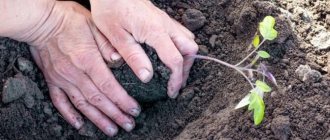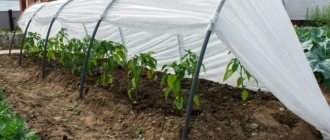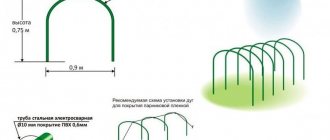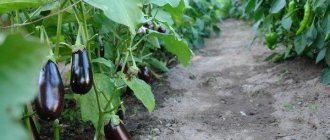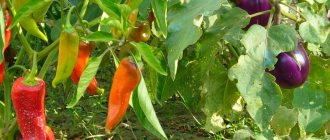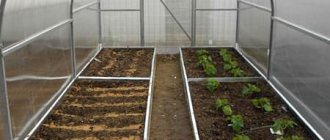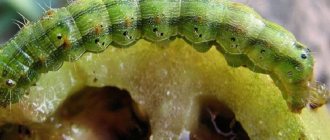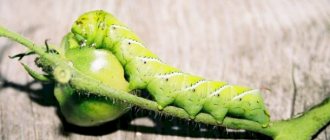OgorodGuruCom
Tips and tricks for gardeners
Popular
Is it possible to freeze tomatoes for the winter in the freezer?
Home › Vegetables › Distance between peppers when planted in a greenhouse or open ground
People who grow peppers and other garden crops want to get a good harvest. Proper planting of vegetables will help ensure good yield. Therefore, before you start planting, you need to figure out at what distance to plant peppers to increase the number of fruits.
Where to plant peppers
In order for young pepper bushes to take root in open ground without problems, you should correctly calculate the time for planting them. The soil temperature should be at least +15 degrees. That is, it is optimal to start transplanting seedlings in the second or third week of May. To eliminate the possibility of night frosts. Seedlings are ready for transplanting into the ground at the age of 2-3 months. Quite strong, which have 3-4 pairs of leaves and a couple of buds.
The landing site must be sufficiently lit. And also protected from the draft wind. Pepper grows best in light, neutral soils that are loose and permeable to air. To make the soil more nutritious, you can dig it up in the fall. And fertilize with complex fertilizers high in nitrogen, phosphorus and potassium. You should avoid planting peppers in an area that was previously devoted to nightshade crops. Such as potatoes, peppers, eggplant, tomato. Because it will reduce their yield.
Why do you need a landing diagram?
It is advisable to use the scheme if garden crops are planted at different times. It is necessary to consider what kind of care the pepper needs and what kind of care the neighboring bushes need. A properly calculated space will provide access to fresh air and protect the bushes from diseases of other plants.
Advantages of the scheme:
- saving space in an open area;
- good harvest: stems and foliage develop correctly;
- rapid growth of seedlings;
- vegetables rot less (especially those located in the root part of the plant);
- ease of care;
- proper coverage of culture.
The planting scheme is used for greenhouses and open ground. This is a certain distance required for the growth of the rhizome: if the lack of free space for the bushes is corrected by trimming excess vines, it will not be possible to correct the lack of nutrients from the soil after the seedlings have grown.
The planting scheme allows you to calculate the amount of fertilizer that will be needed in the future. Each bush planted according to the scheme requires at least 2 kg of fertilizers per month. Watering work can be carried out as needed; each bush is clearly visible: you can see how dry the soil is.
Additional terms
If the bushes are tall, you need more free space between them.
If the area chosen for the vegetable is in the shade, the peppers will need more free space. It is important how the vegetables are arranged: if the vegetable appears on the lower stems, the distance between the beds is increased. The quality of fertilizers that are applied before the end of summer is taken into account: if they are covered with a thick layer, the distance from planting to planting increases. The diagram is a conditional boundary of pepper bushes: it is increased to suit the selected seedling variety.
When is the best time to plant peppers?
It is recommended to plant young plants in the evening or in cloudy weather. In order to protect them from direct sunlight and overheating. Because planting in the morning can negatively affect the process of adaptation of seedlings to a new location. Before removing pepper bushes from containers, they must be thoroughly moistened. At least 3 hours before the transplant procedure. This will make it easier to remove them from the pots.
Seedlings should be removed extremely carefully, holding them by the leaves and keeping a lump of earth around the root system. This will protect it from damage and help you quickly get used to the garden. To speed up the growth and development of the root system, it can be treated with a stimulating drug.
It is recommended to take care of drainage in advance at the place where peppers are planted. Because this crop is very sensitive to excess moisture in the soil. Small pebbles can be placed at the bottom of the planting holes. A normal level of acidity can usually be achieved by pouring a small amount of wood ash into the holes.
We grow seedlings
Pepper seedlings can be grown at home. But you will have to work a little to ensure that by the time of disembarkation she is strong and healthy.
Preparing seeds for planting
The stages of seed preparation include selection, disinfection, saturation with microelements and germination.
Step-by-step instruction:
- Carefully inspect the seeds and remove small and damaged ones. Then make a saline solution: 30 g of salt per liter of water. Dip the seeds into it and after 5-7 minutes remove the ones that pop up - these are barren flowers. Rinse the rest of the planting material.
- Now the seeds need to be treated for fungal infections. To do this, they are soaked in a dark pink solution of potassium permanganate for about 20 minutes. As an alternative, you can use Fitosporin or other fungicide preparations. Don't forget to rinse the seeds after processing.
- The next stage is saturation with nutrients. Mix 20 g of wood ash with a liter of water and leave the mixture for a day to settle. After this, place the seeds in a bag and immerse them in the solution for 5 hours, and then dry them on a piece of paper.
- Place the seeds between layers of damp cloth and put them in a warm place with a temperature of +25 degrees. After a week or two they will germinate. It is not necessary to wait for the seeds to hatch - you can sow the swollen ones.
- Some gardeners harden the seeds before planting. To do this, they are kept warm for 10 days and then put in the refrigerator overnight. This is an optional step, but thanks to it the seedlings will grow stronger.
Seedling care
To grow seedlings, the soil must be neutral acidity, nutritious, moisture-absorbing and loose. The easiest way is to buy it in a special store, but you can prepare it yourself. You will need:
- humus or rotted compost - 2 parts;
- peat – 2 parts;
- washed sand - 1 part.
Make the mixture, sift it and steam it in a double boiler for an hour to disinfect.
Step-by-step instructions for growing seedlings:
Fill the prepared container with soil and place the seeds at a distance of 2 cm
Sprinkle with a centimeter-thick layer of soil, compact and water carefully. Cover with film and put in a dark place with a temperature of +25 degrees. When the seedlings sprout, move them to a bright place
The temperature needs to be lowered to +17. Water moderately and periodically rotate the container relative to the light source. After about three weeks, the seedlings will have one or two leaves. At this time, make a pick in pots with a volume of 100-150 ml. Water carefully and place on the windowsill. Two weeks after picking, do the first feeding and two weeks later - the second. To do this, use Agricola or another fertilizer for seedlings. At the end of spring, transplant the bushes into large pots. Start hardening two weeks before planting. The air temperature must be at least +12 degrees. On the first day, the plants are taken outside or into the greenhouse for 2-3 hours. In the second - for 4-6 hours. On the third - for 10 hours or for the whole day in warm weather. On the fourth day, the seedlings are left to spend the night outside, having previously covered them.
How to plant peppers correctly
It is very important to follow a certain order of planting seedlings to avoid darkening low-growing bushes by taller neighbors. Proper planting will also ensure even distribution of nutrients between plants. Thus, low-growing varieties of pepper should be placed at a distance of 0.4 m from each other. The interval between rows should be at least 0.5-0.6 m. Tall bushes are best planted with an interval of 0.5 m between holes and 0.7 m between beds.
Fertilizer application and soil disinfection
Peppers like fertile soil. Organic fertilizers are usually applied when preparing beds in the fall. In spring it is necessary to add mineral mixtures. For every sq. m add:
- 40 g superphosphate;
- 20 g ammonium nitrate;
- 30 g of potassium sulfate.
Planting in fertile soil is the key to a bountiful harvest. The soil must first be disinfected. For this purpose, treatment is carried out with boiling water. A more reliable way is to use a solution of copper sulfate (1 tablespoon per 10 liters of water). Disinfection is carried out a week before planting seedlings.
Pepper varieties for the greenhouse: 6 best options for 2022
Row Spacing
Placing seedlings in beds is generally considered the most practical. Because this method makes caring for peppers much easier. The 0.7 m by 0.7 m scheme is most popular among gardeners. Because it provides a number of positive aspects:
- the large distance between seedlings allows you to apply fertilizers without damaging neighboring plants;
- this way it is easier to control the spread of fungal infections;
- tying up tall bushes becomes easier;
- watering and spraying bushes located at a large distance from each other is also simplified;
- Weeding and loosening the soil is best done with this particular arrangement of seedlings;
- Harvesting, as a rule, is easier to do in bushes that are far apart from each other.
Caring for young plants in the first month
In the first days after planting, peppers need to be provided with abundant watering, temperature balance, and fertilizing. It is important to monitor for harmful insects and the occurrence of diseases that can lead to the death of seedlings.
How to prevent hypothermia of seedlings?
In regions with frequent temperature changes, it is better to initially plant seedlings in greenhouses or greenhouses. This will prevent the fragile plant from freezing. In warm or hot times of the day, the polyethylene protection can be removed, which will gradually harden the sprouts.
Planting
Planting other crops is not advisable. Young peppers should be in the garden separately from other crops. However, based on the rules of crop rotation, experts recommend selecting optimal neighbors. But in this case, the distance between the pepper bushes should be 5-10 cm wider.
Best neighbors:
- bulb onions;
- tansy;
- spinach;
- marigold;
- nasturtium;
- lovage;
- thyme;
- basil;
- sayoran;
- coriander;
- dill.
All these plants are aimed at repelling pests (as they emit a specific smell) and preventing disease (they have phytoncidal properties).
Watering and loosening
Bell pepper is the only vegetable that adapts to both different watering and loosening. The soil near each seedling should be fluffy. Once a week, it is advisable to deep loosen the soil and twice water thoroughly.
If the ground under the plant is wet, it is better to wait, as a large amount of water contributes to rotting of the stem.
Fertilizing
The first feedings should be varied. This is necessary for the plant to become stronger and absorb all the important vitamins. After flowering, you should slightly reduce the amount of fertilizer. You need to focus on mineral supplements:
- potassium salt (2 tsp);
- Superphosphate (2 tsp);
- water (10 l).
When the first fruits appear, it is advisable to add the following to the mineral fertilizer:
- potassium humate (1 tbsp);
- urea (2 tsp);
- bird droppings (250 g);
- manure (no more than 200 g).
How to plant peppers in a greenhouse correctly
When choosing the option of planting peppers in a polycarbonate greenhouse, it is recommended to adhere to the following schemes:
- 2 rows 1 meter wide;
- 3 rows of 0.7 m.
The interval between bushes depends on the plant variety:
- an interval of 0.35 m is suitable for tall peppers and hybrids;
- Ortas of average height will need 0.25 m;
- early low-growing varieties are planted at a distance of 0.15 m from each other.
The following methods of placing seedlings are highly effective:
- With the wide-row method, the distance between rows is about 0.55-0.65 m. Between seedlings - 0.2-0.3 m.
- The tape method involves planting 2-3 rows of tapes. The optimal interval between tapes is 0.55-0.6 m. Between rows inside the tape is 0.25-0.4 m. Between bushes is 0.2-0.3 m.
- With the square-cluster method, each hole usually contains 2 seedlings with an interval of 0.6 m.
- The staggered distribution requires adherence to a 0.3 m by 0.3 m pattern. It is important to remember the need to ventilate the greenhouse before planting seedlings. Because a humid atmosphere and stagnant air can damage plants. And also provoke their rotting and start the process of rotting. That is why air circulation inside the shelter is vital for planting bell peppers.
Rules for harvesting and its further storage
When harvesting peppers, care must be taken as mistakes will lead to loss of harvest. Instructions for harvesting peppers:
Instructions for harvesting peppers:
- When technically ripe, the fruits are selectively harvested every 6-8 days.
- Remove the peppers using scissors or pruners.
- For better storage, the fruit is cut off along with the stalk.
- When harvesting, you should be careful not to damage the branches of the bush.
- Peppers should be sorted according to size and ripeness.
To enjoy fresh vegetables for as long as possible, you need to properly organize their storage. Peppers can be stored for a month longer than tomatoes and eggplants.
Characteristics of fruits for storage:
- technical maturity has been achieved;
- no mechanical damage;
- there are no signs of damage, cracks or dents.
Storage conditions
Thin-walled peppers should be stored in the refrigerator. Before sending it for freezing, part of the stalk should be cut off from the fruit, leaving its small tip.
For storage in basements and cellars, containers are used - boxes and plastic bags. Gardeners prefer bags because they do not allow air to pass through, which means vegetables are stored better. To extend the freshness period, each fruit can be wrapped in a layer of paper.
Requirements for plastic packaging: thickness - at least 120 microns, presence of a membrane with perforation on the side wall.
The temperature in the storage area for vegetables that have reached technical ripeness should not exceed 8-10°C with a humidity level of 80-90%. Under these conditions, the pepper will ripen in a month. To speed up ripening, it is moved to a warmer place.
Ripe fruits are stored at a temperature of 1°C. Their ripeness will be reached in 2 months. Green varieties last longer than yellow or red fruits.
Some vegetable growers prefer not to pick peppers from the bush. The plant is removed from the ground and hung upside down. Bushes can be stored in a shed or basement.
How to plant peppers in the beds correctly
As mentioned above, an open area for growing peppers should be protected from drafts as much as possible. Fences, outbuildings and residential buildings can serve as shelter from the wind. As well as dense crowns of bushes. As a rule, it is best to plant peppers after carrots, cucumbers, beets, cabbage, and zucchini. The distance between the holes is selected according to the type of pepper:
- 0.4-0.5 m between hybrids and tall plants;
- 0.3-0.35 m between medium-sized peppers;
- 0.2-0.25 m between low-growing varieties.
The ideal interval between beds is 0.6-0.7 m. The depth of the hole should approximately correspond to the bayonet of the shovel.
Planting tall varieties usually requires the presence of pegs about 0.7 m high. The stems will subsequently be tied to them. Warm beds are an ideal solution for growing peppers. You can build a warm bed as follows:
- from boards 0.4 m wide you need to knock down a box 1 m wide and of arbitrary length;
- The bottom of the box is lined with cardboard. It will inhibit the growth of weeds;
- A drainage layer of waste with a long rotting life is laid out on the cardboard. These are woody branches and stems of corn and sunflowers;
- the next layer includes food waste, grass, cabbage leaves. Potato or tomato tops are not suitable. Because it contains late blight, which is dangerous for plants;
- the contents of the box are spilled with water and thoroughly compacted;
- The last layer is laid with foliage sprinkled with earth. The thickness of the earthen layer is 0.15 m;
- the soil is disinfected with a hot solution of potassium permanganate.
The rotting of the layers that make up the bed will ensure constant heating of the root system of the peppers.
Despite the nutritional properties of fresh manure, adding it to a warm bed is not recommended. Because this will lead to an excess of nitrogen and the formation of powerful green mass.
Features of cultivation
When planting and growing peppers, you should follow some rules.
- The optimal planting time is early to mid-May. Pepper seedlings are planted when the seedlings reach a height of 25 cm, have 12-14 true leaves and are 60 days old.
- Plants are planted in fertile and light soil, with the preliminary application of complex fertilizers, peat and humus.
- The depth of the hole is up to 15 cm, allowing you to deepen the plant to the first pair of leaves, giving the opportunity for the development of a strong root system.
- It is recommended to transplant seedlings in the evening.
- As tall varieties of peppers grow, it is recommended to tie the bushes to stakes dug into the ground, up to 60 cm high. This technique will protect the plants from breaking off under the weight of ripening fruits.
- When growing peppers, you should shape the bushes by pinching out weak shoots.
- Compliance with basic agricultural practices - frequency of watering and fertilizing, loosening and removal of weeds, maintaining temperature conditions and mulching of plantings will allow you to obtain abundant harvests of peppers.
- To increase the number of ovaries on the bushes, when cultivated in a greenhouse, it is recommended to tap the peppers from time to time, improving their pollination. It is worth considering that planting hot and sweet pepper varieties together leads to cross-pollination of the varieties and a low-quality harvest. Therefore, these types of peppers should be grown only in separate greenhouses.
- If pests are detected, only preparations of biological origin should be used to combat them.
An optimal planting scheme will help you get a good pepper harvest.
Advice! When cultivating peppers in a greenhouse, it is recommended to choose large-fruited and high-yielding varieties and hybrids: “Rubik’s Cube”, “Latino”, “Dennis”, “Early”, “Monterro” and others, as well as take into account recommendations for choosing zoned varieties.
By choosing the optimal planting scheme and creating the necessary agrotechnical conditions for peppers, you can be confident in the quality and abundance of the future harvest.
